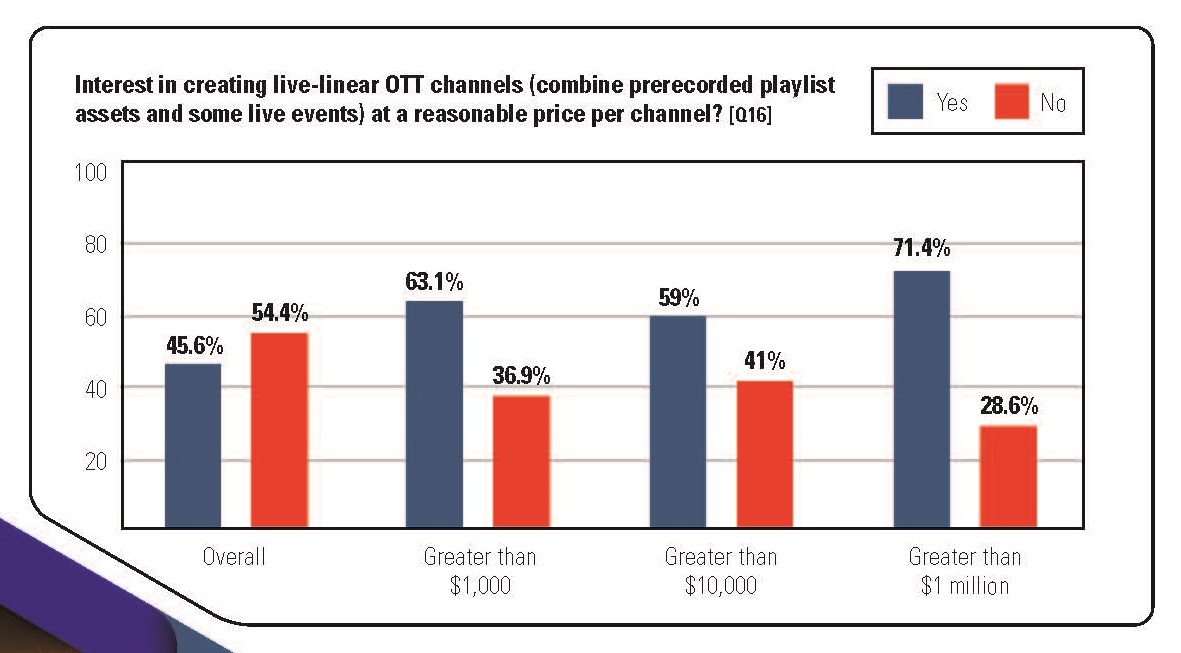
Revenue growth is set to surge among OTT content publishers, large and small, with live linear channels a hot strategy.
A fresh report published at StreamingMedia and sponsored by Tulix seems to bear this out.
More than half of respondents to its survey — conducted in the first half of 2021 — are expecting at least a 26% growth in the next 18 months, and two-thirds of respondents that report higher-end revenue are expecting a growth of over 25%.
Even on the high end of revenues — those who claim more than $25 million annual OTT-based revenue — more than half of those expect their annual revenue to grow by at least 11% – 25% between 2020-2022.
CHARTING THE GLOBAL MARKETPLACE:
Big content spends, tapping emerging markets, and automated versioning: these are just a few of the strategies OTT companies are turning to in the fight for dominance in the global marketplace. Stay on top of the business trends and learn about the challenges streamers face with these hand-curated articles from the NAB Amplify archives:
- How To Secure the Next Billion+ Subscribers
- Think Globally: SVOD Success Means More Content, Foreign Content and Automated Versioning
- How Does OTT Gain Global Reach? Here’s Where to Start.
- Governments Draw Battlelines To Curb the US Domination of SVOD
- Streaming Content: I Do Not Think You Know What That Word Means
For those who have more than 10,000 monthly viewers or subscribers, almost three-quarters expect growth of more than 11% between 2020 and 2022, while a third expect growth of 50% or more in that same period.
While on-demand OTT continues to grow, it is being outpaced by live and live-linear. The live-linear concept is essentially a playlist that combines pre-recorded assets, interspersed with some live events, and is streamed live in much the same way as a traditional broadcast channel.
Per the report, “The live-linear approach allows for everything from niche channels for small broadcasters that don’t own traditional broadcast infrastructure to additional channels for those broadcasters who want to add additional features such as alternate camera angles or supplemental content.”

When asked if there was interest in creating live-linear OTT channels at a reasonable price per channel, the response was overwhelmingly positive, according to the survey.
The big question is, “What is a reasonable price?” and the answer is quite telling. The overall average based on this survey for an expected reasonable price was $4,876 per month. For those who had very high revenues, a reasonable price was $10,000 or more per channel per month, and some of the responses as to a reasonable price were in the six-figure range. But those higher-end “reasonable price” responses only accounted for 12% of overall responses.
Also noted: the growing live-event OTT space is rebounding strongly following 18 months of pandemic-induced lockdowns and social distancing.

One question left unanswered in the survey is how much revenue will be impacted by the higher cost of live production. This is especially pertinent in 2021, when we’ve seen major sporting events re-emerge, but with significant additional production costs. Worse still, global events like the Olympics, which were delivered from almost-empty venues, are being forced to accommodate significant production costs in terms of maintaining social distancing between athletes, production crew, and venue representatives while still bringing global audiences the intimate and dynamic experiences they expect from coverage of these major events.
On the tech spec front the survey noted that average data rates and resolutions for OTT hover around 5Mbps and 1080p 24/25 frames per second, respectively.
There’s still a significant amount of 720p content being served up, as well as 1080p60 — a good frame rate for sporting events — but relatively little 4K content.
“We could chalk up this lack of 4K delivery to a number of factors, including requests by European governments in 2020 to limit the amount of bandwidth consumed by OTT, but this is another area we’ll watch closely heading into 2022.”


